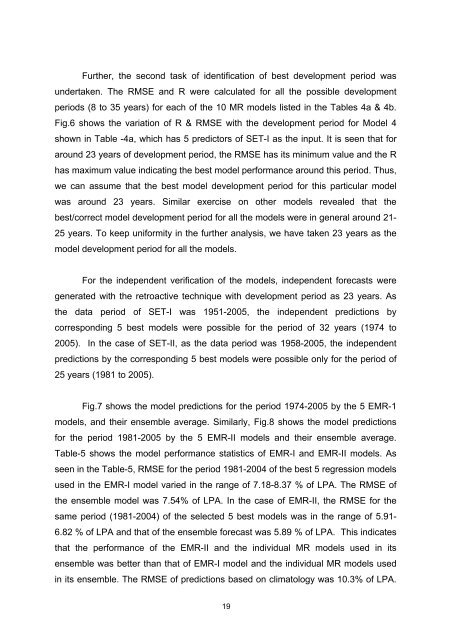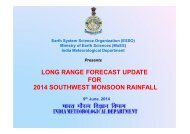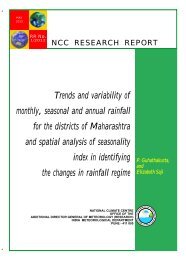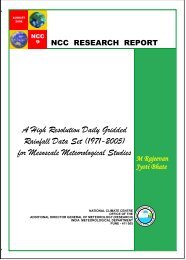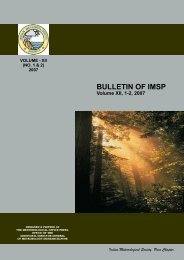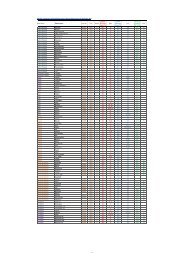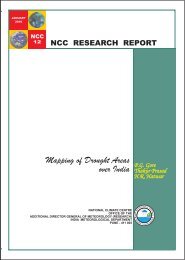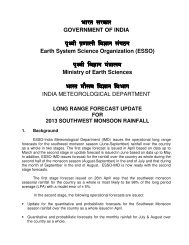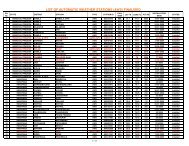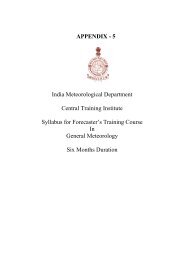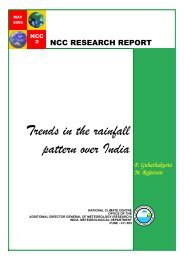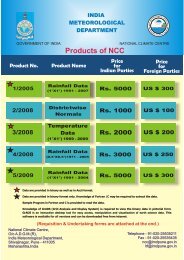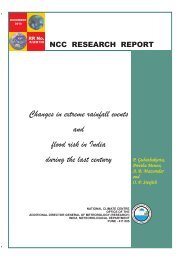NCC Report No. 1 - (IMD), Pune
NCC Report No. 1 - (IMD), Pune
NCC Report No. 1 - (IMD), Pune
You also want an ePaper? Increase the reach of your titles
YUMPU automatically turns print PDFs into web optimized ePapers that Google loves.
Further, the second task of identification of best development period wasundertaken. The RMSE and R were calculated for all the possible developmentperiods (8 to 35 years) for each of the 10 MR models listed in the Tables 4a & 4b.Fig.6 shows the variation of R & RMSE with the development period for Model 4shown in Table -4a, which has 5 predictors of SET-I as the input. It is seen that foraround 23 years of development period, the RMSE has its minimum value and the Rhas maximum value indicating the best model performance around this period. Thus,we can assume that the best model development period for this particular modelwas around 23 years. Similar exercise on other models revealed that thebest/correct model development period for all the models were in general around 21-25 years. To keep uniformity in the further analysis, we have taken 23 years as themodel development period for all the models.For the independent verification of the models, independent forecasts weregenerated with the retroactive technique with development period as 23 years. Asthe data period of SET-I was 1951-2005, the independent predictions bycorresponding 5 best models were possible for the period of 32 years (1974 to2005). In the case of SET-II, as the data period was 1958-2005, the independentpredictions by the corresponding 5 best models were possible only for the period of25 years (1981 to 2005).Fig.7 shows the model predictions for the period 1974-2005 by the 5 EMR-1models, and their ensemble average. Similarly, Fig.8 shows the model predictionsfor the period 1981-2005 by the 5 EMR-II models and their ensemble average.Table-5 shows the model performance statistics of EMR-I and EMR-II models. Asseen in the Table-5, RMSE for the period 1981-2004 of the best 5 regression modelsused in the EMR-I model varied in the range of 7.18-8.37 % of LPA. The RMSE ofthe ensemble model was 7.54% of LPA. In the case of EMR-II, the RMSE for thesame period (1981-2004) of the selected 5 best models was in the range of 5.91-6.82 % of LPA and that of the ensemble forecast was 5.89 % of LPA. This indicatesthat the performance of the EMR-II and the individual MR models used in itsensemble was better than that of EMR-I model and the individual MR models usedin its ensemble. The RMSE of predictions based on climatology was 10.3% of LPA.19


